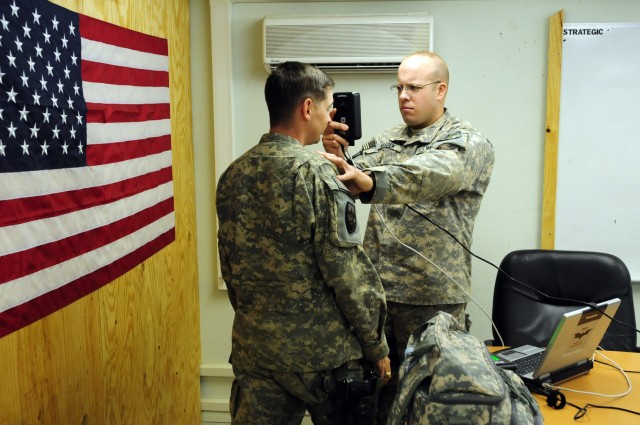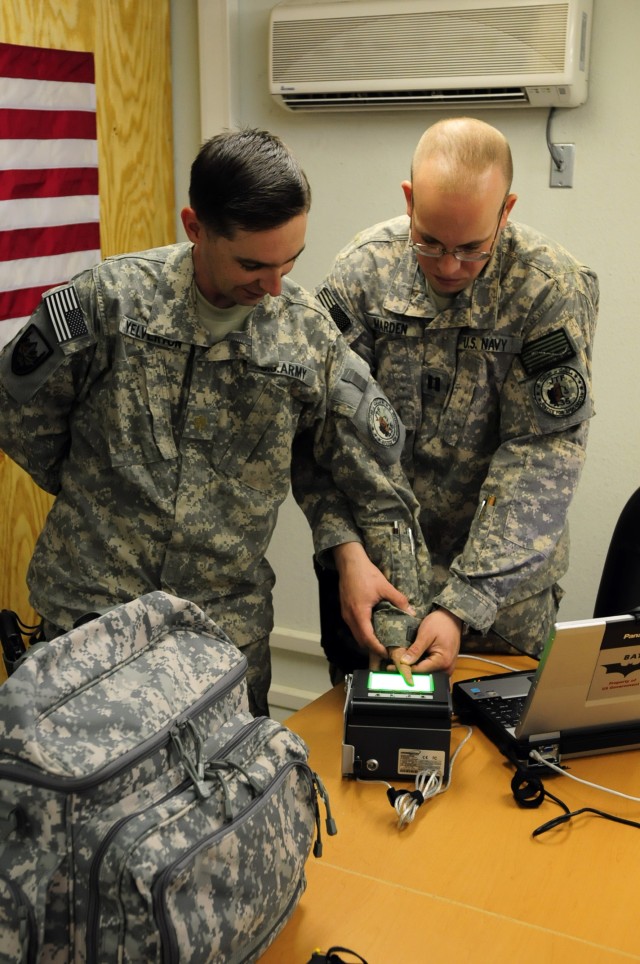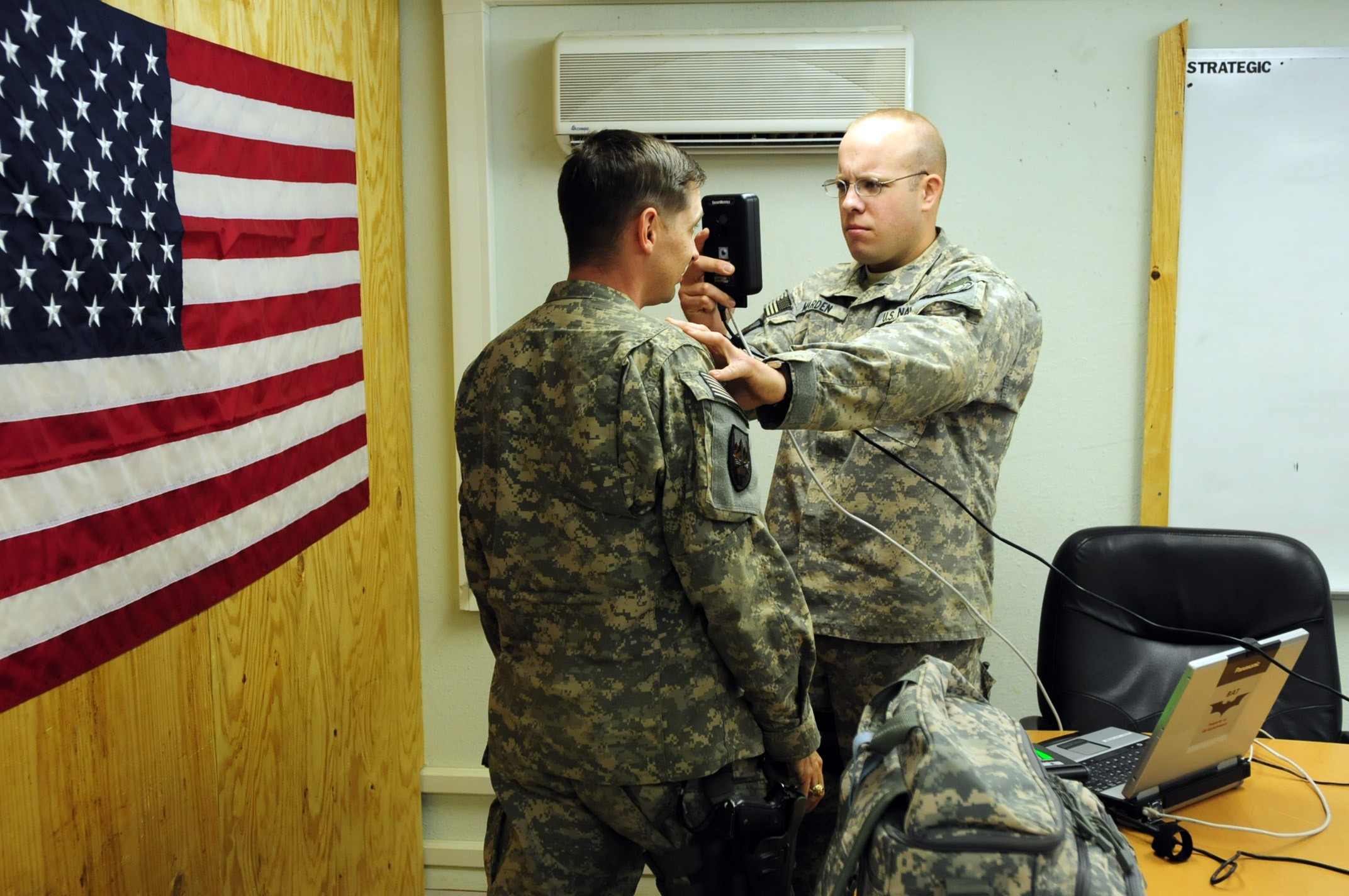BAGRAM AIRFIELD, Afghanistan (Aug. 14, 2010) - Coalition forces in Afghanistan have various ways of gathering information to determine if members of the Afghan population are insurgents or innocent. With the scan of an eye, biometrics has made the process easier. There are multiple biometric systems used in today\'s military: the biometrics automated toolset, the hand-held interagency identity detection equipment and the secure electronic enrollment kit. "They make life easier," said U.S. Army Staff Sgt. Gregory Scarborough, 3rd Battalion, 320th Field Artillery Regiment, 3rd Brigade Combat Team, 101st Airborne Division, base defense non-commissioned officer in charge. The method of getting a never-before-scanned individual in the biometric database is called enrolling. This consists of gathering the subject's fingerprints, facial picture and/or an iris scan. Personal information including name, province, district and reason for the enrollment are also put into each enrollment file. "Our platoon uses the HIIDE and BAT system to help with census," said U.S. Army Sgt. Benjamin G. Olivarez, a native of Clarksville, Tenn., from Company B, 2nd Battalion, 327th Infantry Regiment, 1st BCT, 101st Abn. Div. There are three types of characteristic recognition associated with the BAT: fingerprints from all fingers on both hands, facial, which requires a photograph of the subject, and an iris scan of both eyes. The HIIDE is compact, and requires only fingerprints of the index finger and the thumb on both hands. It also has an iris scanner that requires less time for a response from its database on personnel who are already in the system. "If they are already in the system, they pop up quick," said Scarborough, a native of Fayetteville, N.C. "We keep the system with us on patrol to I.D. people to see if they would pop up." The SEEK is most used by special forces due to it having the same characteristics as the HIIDE but quicker to capture an image of the subject's iris, and its lightweight design. Like the other machines, the SEEK has a fingerprint scanner. When materials like cell phones, weapons and improvised explosive devices are found, they are taken to labs by coalition forces to get as much information as they can about the items. If there are fingerprints, they are scanned to a biometrics system. These fingerprints are stored in the system database, so if a person were to get detained or enrolled by coalition forces, and it happened to be the same individual from a previous attack where fingerprints were scanned, it would pop up on the system with information regarding the previous enrollment. "Right now, there are over 18,000 unknown fingerprints that are in the database," said U.S. Army Maj. Guy Yelverton, a native of White Plains, Md., and the Task Force Biometrics, Joint Task Force 435, executive officer. There have been a couple of villages that have been enrolled because the village elder said they wanted to prove that they support the Government of the Islamic Republic of Afghanistan and are against Taliban, Yelverton said. "It allows non-criminal males to have an easier time finding work, because if they haven't been involved in criminal activity, it helps," said U.S. Army Capt. Michelle Weinbaum, Task Force 435, Task Force Biometrics operations officer, and a native of Cranston, R.I. "It's not only proof of involvement, but also proof of non-involvement." In 2009, there were more than 200,000 enrollments put in the system. Yelverton said 210,000 have been added already in 2010. "Our goal is to get to 1.65 million enrollments," said Yelverton. "We are currently in the process of contracting out an Afghan company, to provide Afghan enrollers, to go around the country and work at border crossing points, international airports, district headquarters and district jails," he said. In addition, there was a program in Kandahar where coalition forces hired Afghans to enroll Afghans using the HIIDE. The program has been turned off for about two weeks now, said Yelverton. "We were told that we will be able to continue operations once our force protection assets are back into place by the local military police company," said Yelverton. "Afghans enrolling Afghans really works. "Not only did they do an awesome job, Afghans lined up to get enrolled by other Afghans." As the number of enrollments climbs, it will become easier for coalition forces to tie the crimes to the criminals.
Biometrics: Giving Afghans an identity
By U.S. Army Sgt. Grant Matthes, Regional Command-East Public Affairs OfficeAugust 25, 2010
RELATED STORIES
- November 17, 2021The U.S. Army releases a two volume book about Operation Enduring Freedom
- April 23, 2020Army announces upcoming 4th Security Forces Assistance Brigade, unit rotation
- April 23, 2020Army announces upcoming 4th Infantry Division Combat Aviation Brigade, unit rotation
- January 17, 2020Army announces upcoming 10th Mountain Division Headquarters unit rotation
- August 16, 2019Army announces upcoming 3rd Security Force Assistance Brigade unit rotation
- August 16, 2019Army announces upcoming 10th Mountain Division Combat Aviation Brigade unit rotation
- October 18, 2018Department of the Army announces upcoming 1st Cavalry Division Headquarters unit rotation
- July 26, 2018Department of the Army announces upcoming 4th Infantry Division Headquarters deployment
- April 18, 2018Department of the Army announces upcoming 101st Airborne Sustainment Brigade deployment
- December 21, 2017Department of the Army announces upcoming 1st Stryker Brigade, 4th Infantry Division deployment
- August 30, 2017Department of the Army announces 3rd Infantry Division deployment
- March 29, 2017Department of the Army announces 1st Armored Division's Sustainment Brigade deployment
- December 8, 2016Department of the Army announces 16th Combat Aviation Brigade, 7th Infantry Division deployment
- December 8, 2016Department of the Army announces 1st Brigade Combat Team, 1st Armored Division deployment
- March 3, 2016Department of the Army announces upcoming deployment
- January 8, 2016DA ANNOUNCES ROTATIONAL DEPLOYMENTS




Social Sharing